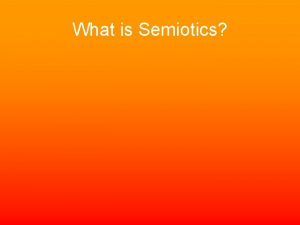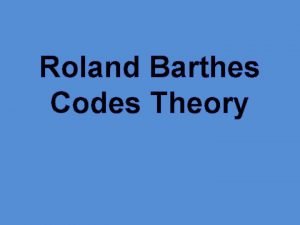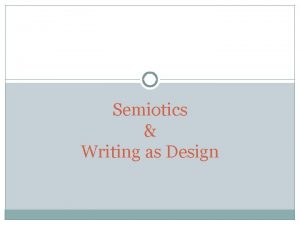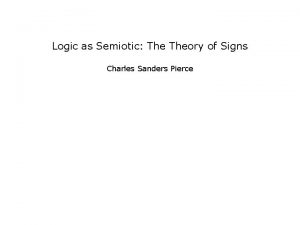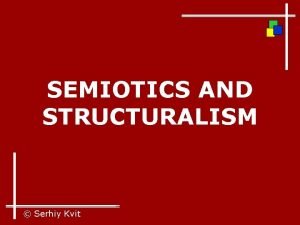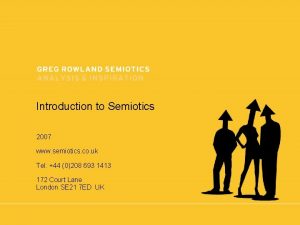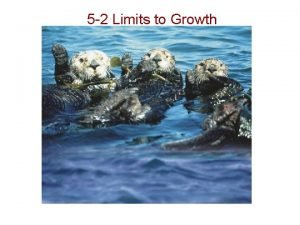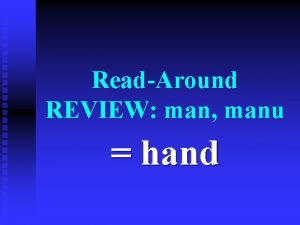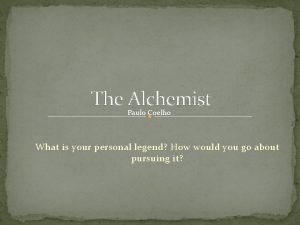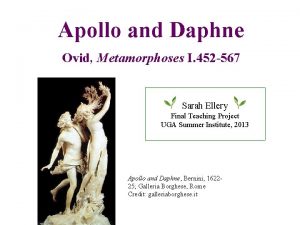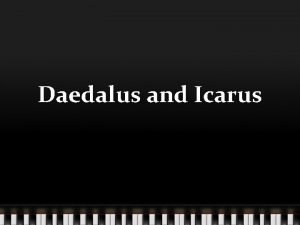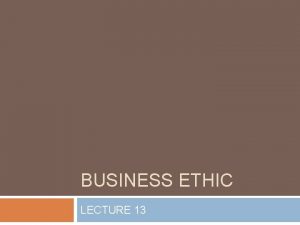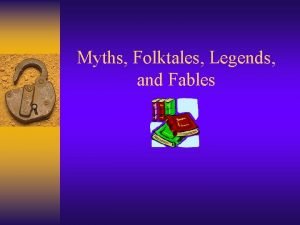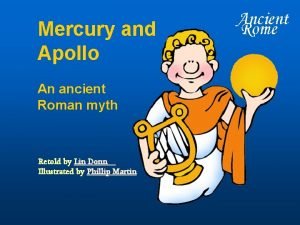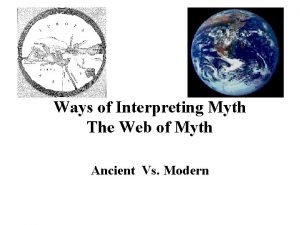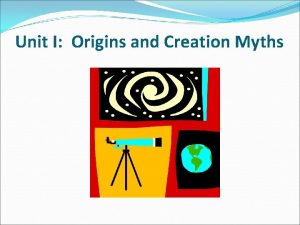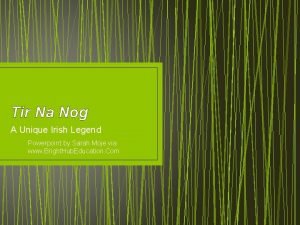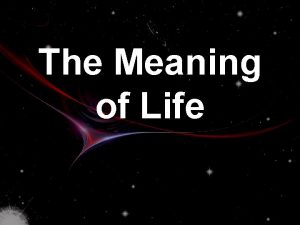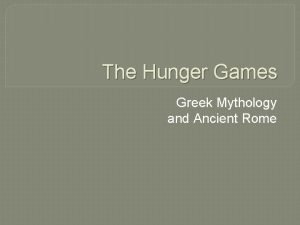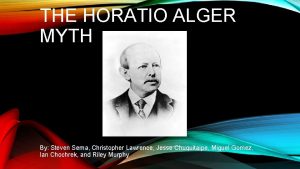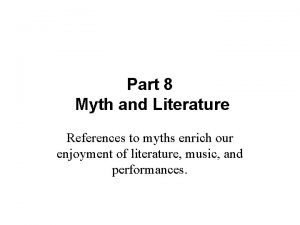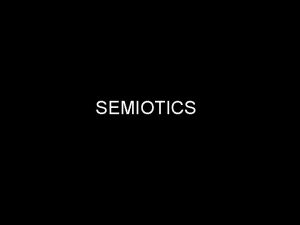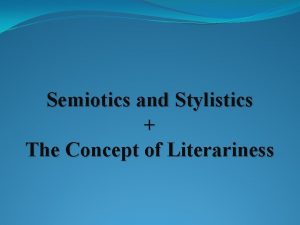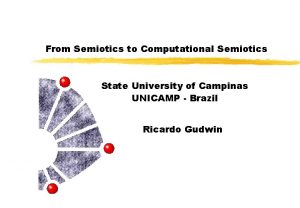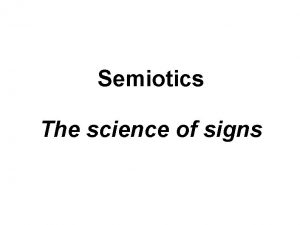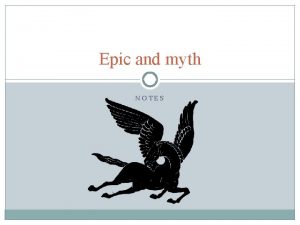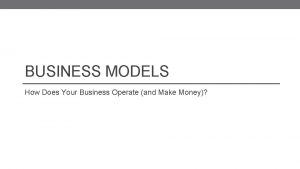Myth and Semiotics Myth HOW DOES MYTH OPERATE






































![Archetypes A femme fatale is a mysterious and seductive woman[1] whose charms ensnare her Archetypes A femme fatale is a mysterious and seductive woman[1] whose charms ensnare her](https://slidetodoc.com/presentation_image_h2/0d6f283bca650afcbe5fb2c41120e851/image-39.jpg)







- Slides: 46

Myth and Semiotics

Myth HOW DOES MYTH OPERATE IN THE TEXT YOU HAVE CHOSEN TO TRANSFORM? HOW WILL YOU DISRUPT THE TEXT BY CHALLENGING MYTH WITHIN IT? WILL YOU DISRUPT THE MYTH FROM THE PERSPECTIVE OF FEMINISM, MARXISM OR POST COLONIALISM?

Myth Roland Barthes used this term in Mythologies to describe the way certain stories and images function to shape our perception of reality. Ideology underpins myth. (Well, ideology underpins everything really – discourse, myth. . )

Myth: Barthes argues that the orders of signification called denotation and connotation combine to produce ideology in the form of myth …… myths operate through codes and serve the ideological function of naturalization. e. g. myth of motherhood, of childhood, of crocodile, of the noble savage, of hunting and gathering, of beauty, of femme fatale, of black man, of oriental. At: http: //www. aber. ac. uk/media/Documents/S 4 B/semgloss. html#M

Myth “……'myth' as recurring themes, icons and stereotypes which claim common recognition within a cultural group with a shared ideology……………. Ideology we define as the grid of significations which organizes myths in the legitimation of particular social, economic and political relations. ” At: http: //ccms. ukzn. ac. za/index. php? option=com_cont ent&task=view&id=625&Itemid=72

Myths are signs which are all around us in our culture. (mothers, fathers, babies, little girls, little boys, witches, coloured people, orientals, the country, the city …) Barthes says myths impose upon us the belief that something simply ‘goes without saying’; they create a perception of the falsely obvious. (Hoirihan p 12)

Myth In modern literary and cultural study, myth refers to a shared way of understanding the world that is activated through representations in texts. E. g. a representation of a wolf activates all kinds of culturally embedded ideas about the nature of wolves as predators and werewolves.

Myth This kind of myth is related to the signs and categories through which a community view the world, so that knowing the myth is part of what it means to be a member of the culture. See : http: //ceasefiremagazine. co. uk/in-theory-barthes-2/

Myth in your text? The black man(“Noddy”) The seductress (“La Belle Dame Sans Merci”) Beauty (“Cinderella”) Myth Many aspects of cultural life are understood through myth. Motherhood, for example, is a powerfully mythologized cultural role. Representations of motherhood in texts often activate ideas to do with nurturing, selfsacrifice, gentleness, femininity, purity, domesticity and more.

What ideas are activated? What intertextual references contribute to myth? E. g. stories about golliwogs. See Hourihan p 58 -62 for racial myths.

Myth Gunga Din: What ideas are activated? E. g. servility, selfsacrifice, lack of education/civilisation. Is this the myth of the ‘noble savage’? Did you know there was a movie named Gunga Din made starring Gary Grant which may have helped to perpetuate this myth of the Indian ‘native’. Question: Who were the British fighting when Gunga Din sacrificed himself so nobly?

Gunga Din Of interest: Dear old Gunga Din who "despite 'is dirty 'ide, 'e was white all white inside, as 'e went to fetch the water under fire. " In the Hollywood version, good old white inside Gunga blew the trumpet for the British against his own people, and just how whiter inside could a noble savage be?

Myth The Australian swagman: What are the characteristics of the myth? • A loner • Lives in the open, travels by foot • Lives off the land, performs menial tasks for food and shelter • Lives on the margin of society Impoverished – begs but may be proud • May be unemployed or unemployable • Lives on charity of rural folk • May not be trustworthy • an underclass of transient temporary workers What ideas are activated? Walzing Matilda

Myth and Ideology The jolly swagman is seen as a crook, a vagabond who lives by petty thievery; he respects neither the ruling class of the squatters, nor the law-enforcing agents, the troopers. The ideology supports the status quo – it is wrong to steal from the wealthy even if you are starving.

Myth of Eve • • • The temptress – an archetypal character The cause of the fall of man Adam as victim of Eve as by-product – Adam’s rib Intertextual relationship with Pandora who was also responsible for bringing evil into the world

What ideas are activated? What intertextual references are relevant contribute to the myth of the seductress? See Hourihan references to “La Belle Dame Sans Merci”. .

What ideas are activated? What intertextual references are relevant contribute to the beauty myth? E. g. in The Odyssey and the Iliad (Helen of Troy) See Hourihan references to Cinderella.

Myth “Cinderella”: How do little girls live up to the beauty myth perpetuated by representations of princesses in fairy tales? How do they react to myths about what it means to be feminine, which is to be passive and subordinate to the masculine?

Myth A myth is a textual representation of a shared understanding about the world. Myth is a pre-packaged set of beliefs and practices that seem natural and obvious to members of a culture.

Myth Consider the myth of the country and an idyllic rural activated in the opening lines of “Out, Out”: the beauty and serenity of nature, the dignity and worth of hard manual labour, the prescribed yet natural gender roles…

Myth Consider the beauty myth operating in fairy tales. This ideal is to become a beautiful princess that is fair, youthful, pure, angelic, and precious. See Naomi Wolf – The Beauty Myth Also see The Hidden Morals Of Fairy Tales - Dr Zaius

Myth Texts use combinations of signs (words or images taken from the culture) to invite readers to ‘activate’ or recognize the myth. For example, “Once there was a dear little girl whom every one loved” activates myths of childhood and girls – innocence, virtue, honesty, love, and beauty.

Semiotics To explain how myth works Barthes uses the linguist Saussure’s concept of the sign.

Semiotics Signs work in a culture. Barthes identifies two orders of signification: the first is that of denotation, the second is that of connotation and myth and occurs when the meanings of the sign (e. g. the word ‘princess’) meet the values and established discourses of the culture.

Semiotics The first order of signification: denotation. This refers to the simple or literal relationship of a sign to its referent. It assumes that this relationship is objective and value-free—for all their differences, the words 'horse', 'steed' and 'nag' all denote the same animal. The dictionary meaning….

Semiotics The second order of signification: connotation. This occurs when the denotative meaning of the sign is made to stand for the value-system of the culture or the person using it. It then produces associative, expressive, attitudinal or evaluative shades of meaning.

Semiotics What are the connotations for a pig? You are evaluating, expressing attitudes and making associations when you construct connotations.

Semiotics and Myth The second order of signification: myth. Barthes's rather specialized use of the term myth refers to a chain of concepts widely accepted throughout a culture, by which its members conceptualize or understand a particular topic or part of their social experience. Thus our myth of the countryside, for example, consists of a chain of concepts such as it is good, it is natural, it is spiritually refreshing, it is peaceful, it is beautiful, it is a place for leisure and recuperation.

Myth and Semiotics The term myth, then, is not to be used in the layperson's sense of a 'false belief', but in the anthropological sense of a culture's way of conceptualizing an abstract topic.

Myth and Ideology The connotations and myths of a culture are the signs of the culture’s ideology. The way that the varied connotations and myths fit together to form a coherent pattern or sense of wholeness, that is, the way they 'make sense', is evidence of an underlying invisible, organizing principle—ideology.

Semiotics

Semiotics Saussure calls a written symbol (e. g. wolf) a signifier; the signifier evokes a concept, the signified (the reader’s mental idea of a wolf). Therefore, the word, or sign, consists of the signifier and the signified.

Semiotics The crucial point is that the signifier (wolf) does not relate to anything in the physical world (any actual animal); it relates to a mental concept which may involve any number of emotional associations.

Semiotics In the case of the ‘wolf’ these associations might include ‘dangerous’, ‘slavering’, ‘predatory’, ‘shaggy’, “huge fangs’, ‘blood-thirsty’ and so on – all the ascriptions which have led to the persecution and extermination of the wolf in many parts of the world, despite the extreme rarity of actual wolf attacks on humans.

Semiotics What kinds of ideas are associations do we activated through the have for signifiers such representations in your as dragon, witch, base text? princess, ogre, servant etc? What cultural roles does each fulfill?

From: Hourihan, Margery, 1997, Deconstructing the Hero, Routledge, London.

Archetypes

Archetypes An archetype is a universal symbolic pattern. Examples of archetypal characters are the femme fatale, the trickster, the great mother and father, and the dying god. There archetypal stories as well. Examples are stories of great floods, virgin births, creation, paradise, the underworld, and a final apocalypse. True to their universal nature, archetypal characters and stories appear again and again in myths across many diverse cultures. Close to myth but applies to literature whereas myth operates throughout a culture.
![Archetypes A femme fatale is a mysterious and seductive woman1 whose charms ensnare her Archetypes A femme fatale is a mysterious and seductive woman[1] whose charms ensnare her](https://slidetodoc.com/presentation_image_h2/0d6f283bca650afcbe5fb2c41120e851/image-39.jpg)
Archetypes A femme fatale is a mysterious and seductive woman[1] whose charms ensnare her lovers in bonds of irresistible desire, often leading them into compromising, dangerous, and deadly situations. She is an archetype of literature and art. Her ability to entrance and hypnotize her victim with a spell was in the earliest stories seen as being literally supernatural, hence the most prosaic femme fatale today is still described as having a power akin to an enchantress, vampire, witch, or demon. http: //en. wikipedia. org/wiki/Femme_fatale

Archetypes The phrase is French for "deadly woman". A femme fatale tries to achieve her hidden purpose by using feminine wiles such as beauty, charm, and sexual allure. In some situations, she uses lying or coercion rather than charm. She may also be (or imply to be) a victim, caught in a situation from which she cannot escape.

Archetypes In social life, the femme fatale tortures her lover in an asymmetrical relationship, denying confirmation of her affection. She usually drives him to the point of obsession and exhaustion so that he is incapable of making rational decisions.

Archetype • The femme fatale was a common figure in the European Middle Ages, often portraying the dangers of unbridled female sexuality. The pre-mediaeval inherited Biblical figure of Eve offers an example, as does the wicked, seductive enchantress typified in Morgan le Fay. • The femme fatale flourished in the Romantic period in the works of John Keats, notably "La Belle Dame sans Merci" and "Lamia". http: //en. wikipedia. org/wiki/Femme_fatale

Cinderella Archetype • naive, carefree innocent girl • Greeks called her child-woman or ‘the maiden’ • unaware of her sexual attractiveness and other competencies • the willing symbol of fertility.

Cinderella Archetype The ‘child woman’ can be described by adjectives like: compliant, harmonizing, nice and sweet, quiet, simplistic, ‘demure, can’t say no, lacking passion, passive, uncertain, kind, receptive, ability to wait, unassuming, ‘good little girl’, little willpower, pleasing everybody, ‘well behaved child’. http: //www. 9 types. com/movieboard/messages/10 387. html

Golliwog Archetype This stereotype gained notoriety through the 1898 children's book The Story of Little Black Sambo by Helen Bannerman. It told the story of a boy named Sambo who outwitted a group of hungry tigers. "Sambo" refers to Black men that were considered very happy, usually laughing, lazy, irresponsible or carefree. This depiction of black people was displayed in films in the 1900 s. The original text suggested that Sambo lived in India, but this fact may have escaped many readers. The book has often been considered to be a slur against Africans. [6]

Golliwog Archetype Blacks are lazy, vicious, and incapable of any serious improvement", said the popular writer Rudyard Kipling in his School History of England (1911). "Niggers are like monkeys [with] their subnormal sloping foreheads and large protruding lips", said G W Stevens in The Land of the Dollar (1897).
 Semiotics myth examples
Semiotics myth examples What are community dynamics
What are community dynamics Peirce semiotics
Peirce semiotics Hermeneutic code meaning
Hermeneutic code meaning Types of media codes
Types of media codes Semiotics
Semiotics Semiotics
Semiotics Semiotics
Semiotics Connotation of shark
Connotation of shark Semiotics
Semiotics Semiotics in music
Semiotics in music Greg rowland semiotics
Greg rowland semiotics People who own, operate, and take risk of a business
People who own, operate, and take risk of a business Urs motor
Urs motor Unified registration system
Unified registration system Combined gas law
Combined gas law E-mosfet can operate in
E-mosfet can operate in General term for programs used to operate a computer
General term for programs used to operate a computer Business entities that operate in a duel market structure
Business entities that operate in a duel market structure Two businesses operate in contrasting international markets
Two businesses operate in contrasting international markets Graphics monitors and workstations
Graphics monitors and workstations Ethan can operate his camera with only one hand
Ethan can operate his camera with only one hand Programs that operate in a gui environment must be
Programs that operate in a gui environment must be Types of electrical hand tools
Types of electrical hand tools When do density dependent factors operate most strongly
When do density dependent factors operate most strongly To skillfully operate by hand
To skillfully operate by hand Non-cmvs the applicant plans to operate
Non-cmvs the applicant plans to operate Non-governmental health agencies are funded primarily by
Non-governmental health agencies are funded primarily by Describe the dream the alchemist tells to the boy
Describe the dream the alchemist tells to the boy Icarus daedalus summary
Icarus daedalus summary Zoos connect us to the natural world claim
Zoos connect us to the natural world claim Metamorphoses apollo and daphne
Metamorphoses apollo and daphne Time elements in the myth of icarus and daedalus
Time elements in the myth of icarus and daedalus Good business means good ethics myth
Good business means good ethics myth Atalanta and the golden apple
Atalanta and the golden apple Myth vs fable
Myth vs fable Mercury and apollo myth
Mercury and apollo myth Myth and fallacies about non-communicable diseases
Myth and fallacies about non-communicable diseases Hilda tresz
Hilda tresz Charter myth definition
Charter myth definition Creation myth definition
Creation myth definition Tir na nog myth
Tir na nog myth Opportunity myth definition
Opportunity myth definition What does taylor mean
What does taylor mean Hunger games based on greek mythology
Hunger games based on greek mythology What is the horatio alger myth
What is the horatio alger myth Title of sample genres of myth
Title of sample genres of myth


